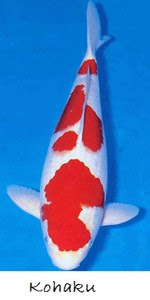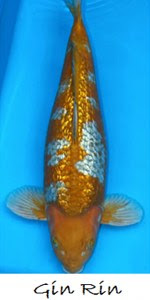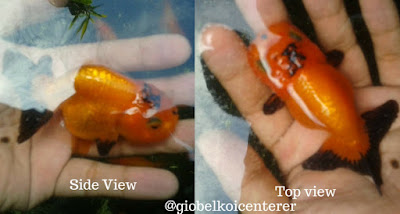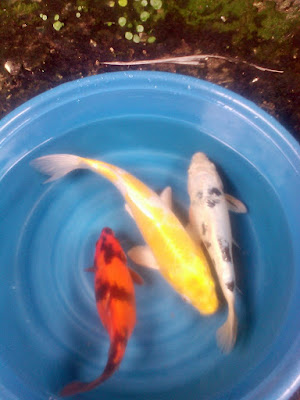Posts
Showing posts from September, 2015
Sakai Fish Farm
- Get link
- X
- Other Apps

Sakai Fish Farm An excerpt from a post that originally appeared on http://caribbeannishikigoi.com/ Sakai Fish Farm in Hiroshima has been in the business of breeding some of the highest quality Koi in Japan for over 100 years. Sakai is considered to be a pioneer in Koi production, adopting various new technologies such as Koi breeding in heated water and artificial field ponds. The Sakai Fish Farm has produced several Grand Champions in numerous Koi shows such as the the All Japan Shinkokai and All Japan ZNA shows, just to name a few.
Dainichi Koi Farm
- Get link
- X
- Other Apps

Dainichi Koi Farm Dainichi is one of the biggest and most famous names in Koi. Run by the sons of the deceased high-end Koi breeder Minoru Mano, Dainichi Koi Farm thrives as one of the busiest and most professional Koi outlets in the Japan with 3 state of the art facilities in Niigata, the home of the Nishikigoi. Dainichi concentrates heavily on body shape, and the original Dainichi was quite huge and impressive. Dainichi Koi Farm still uses parent Koi left to them by their father, breeding prize winning Kohaku, Sanke and Showa varieties. Dainichi Koi have been champions in the All Japan, ZNA and Nogyosai Koi shows over the years.
Taisho Sanke
- Get link
- X
- Other Apps

Taisho Sanke An excerpt from a post that originally appeared on http://caribbeannishikigoi.com/ Taisho Sanke, or Sanke for short, are koi with a solid white base overlaid by patterns of both red and black. It is commonly said that a high quality Sanke pattern begins with a great Kohaku pattern, to which the black is a welcome complement.
Tancho Sanke
- Get link
- X
- Other Apps

Tancho Sanke An excerpt from a post that originally appeared on http://caribbeannishikigoi.com/ Tancho Sanke is characterized by a red circle over its head where the rest of the body is white with beautiful black spots. In breading the desired traits are that the colors are symmetrical and placed in visual balance in reference to the other features of the fish. The beautiful pattern and balance of colors make it a perfect example of a great looking Koi. The brilliant white color is stunning and eye catching. Its body and the form are very exquisite, while the depth of black and rich vibrant color is truly a site to behold. The patterns of the Koi are very unique and only few of the Tancho arise from a spawn, thus looking for the best Tancho is just close to seeking for a needle in a haystack. The white body color of the Tancho Sanke is typically known as shiroji or white ground. It is distinct for its sumi or black pattern with the lone at the he...
KOROMO
- Get link
- X
- Other Apps

KOROMO An excerpt from a post that originally appeared on http://caribbeannishikigoi.com/ Koromo means "robed" or "veiled", which are similar to the Kohaku with white skin and patterns. The only difference is the additional vignette on the colored markings. The unique patterns are well appreciated in Koromo. In 1950s, the Japanese have developed Koromo by crossbreeding of Asagi and Kohaku. Koromo means "robed" or "veiled", which are similar to the Kohaku with white skin and patterns. The only difference is the additional vignette on the colored markings. The unique patterns are well appreciated in Koromo. There are three varieties of Koromo. First is Budo Goromo. It is almost similar to Kohaku having a white body with patches, however, it defers with the blue grape like clusters over its red markings. The shape of its scales looks like bunches of grapes. The second is, Ai Goromo which is also similar to Kohaku, but it has a black or...
Kohaku
- Get link
- X
- Other Apps

Kohaku An excerpt from a post that originally appeared on http://caribbeannishikigoi.com/ Kohaku is one of the most beautiful and popular Koi in the world. It is very simple, yet very elegant variety. It has been said that most of the hobbyist started and finished with the Kohaku. Kohaku means red and white and was established in Japan in early 1800. During that time, Japanese rice farmers observed a red and white mutations started occurring within the common carp. Then, in 1888, Mr. Kunizo Hiroi bred a female Koi with redheaded marking similar to cherry blossoms. After that, all of the well known Kohaku bloodlines were established. Kohaku is one of the most beautiful and popular Koi in the world. It is very simple, yet very elegant variety. It has been said that most of the hobbyist started and finished with the Kohaku. Kohaku are white Koi with red markings. Its value depends on the white skin, since it should be pure, no yellowing, with no stains or other ble...
Gin Rin
- Get link
- X
- Other Apps

Gin Rin An excerpt from a post that originally appeared on http://caribbeannishikigoi.com/ Kin Gin Rin is abbreviated to "Gin Rin" by Koi hobbyist, breeders and sellers. It is literally means "golden silver reflective scales". However, Kin Gin Rin is not a variety of Koi. It is a reference to a Koi's scale. Kin Gin Rin is abbreviated to "Gin Rin" by Koi hobbyist, breeders and sellers. It is literally means "golden silver reflective scales". Kin Gin Rin Koi was developed by Mr. Elizaburo Hoshino. It was 1929 when Mr. Hoshino came across a fisherman who had caught Magoi with many sparkling scales that catches his eyes. That fish was used in the development of Gin Rin. Kin Gin Rin is not a variety of Koi. It is a reference to a Koi's scale. For example, on a red fish such as a Kohaku, when Gin Rin appears - it has a gold appearance that you can easily notice. Scales appear golden when they cover red pigment. On the other ...
Doitsu Koi
- Get link
- X
- Other Apps

Doitsu Koi An excerpt from a post that originally appeared on http://caribbeannishikigoi.com/ Most of the genetic make up of Koi varieties today, do have Doitsugoi blood. Doitsu Hariwake, Doitsu Kohaku, Doitsu Sanke, Doitsu Showa and Doitsu Yamato Nishiki just to name a few. Doitsu Koi went through centuries of selective breeding and most of the time rated highest rating fish can receive. In the late 1800’s German Koi were imported in Japan to improve the supply of edible fish, since it did not have scales with a bulkier body shape which means more meat to eat. Also, another purpose of importation is to cross-breed the German carp with the indigenous carp. Two German scientists, selected 40 fry of the best quality available in their country, then transported all of it to Japan. Only 7 carp survived the trip as it is during the Japanese-Russo War. 6 leather carp and 1 mirror carp turned out to be the genetic backbone of Doitsu as we know today. To compare with Jap...
Asagi
- Get link
- X
- Other Apps

Asagi An excerpt from a post that originally appeared on http://www.caribbeannishikigoi.com/ The Asagi is one of the oldest breeds of Koi. Asagi Koi can be easily recognized by its shade of blue. As a matter of fact, “Asagi” is a Japanese word for pale blue or indigo. That’s why the ideal Asagi’s back all the way up to its head is covered with a defined diamond shape of a non-metallic pale blue to dark blue scales. Magoi In fact, about 160 years ago when Japanese purposely used Magoi (a food, wild black fish) in order to transform it into Asagi. Before Koi were ever imagined, Asagi is the first recognized as ornamental carp. Asagi Koi can be easily recognized by its shade of blue. As a matter of fact, “Asagi” is a Japanese word for pale blue or indigo. That’s why the ideal Asagi’s back all the way up to its head is covered with a defined diamond shape of a non-metallic pale blue to dark blue scales. There are different types of Asagi Koi. If splotches of r...
HIGH RANCHU: SECOND CULL - THE TAIL IS STILL IN FOCUS
- Get link
- X
- Other Apps

